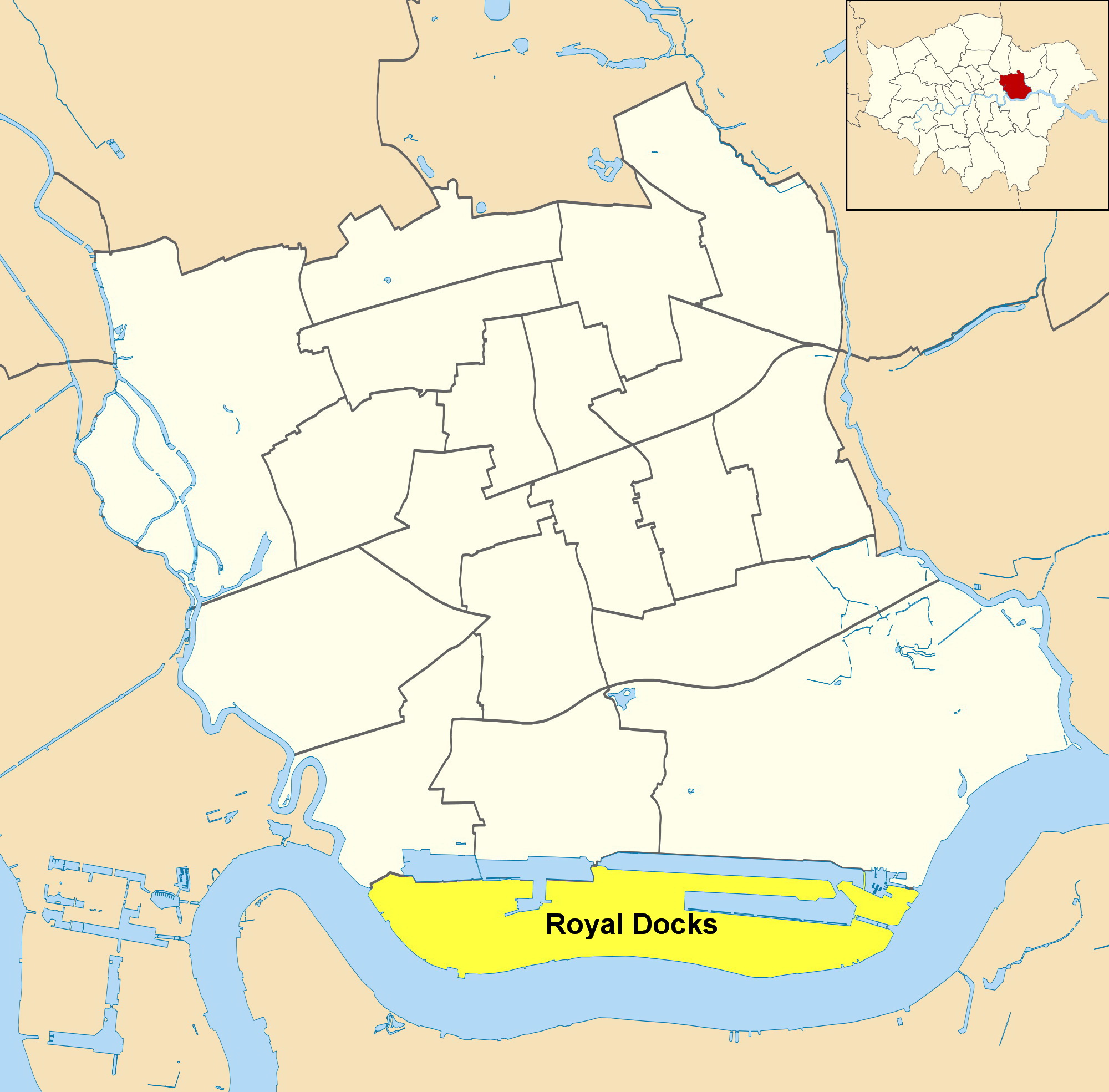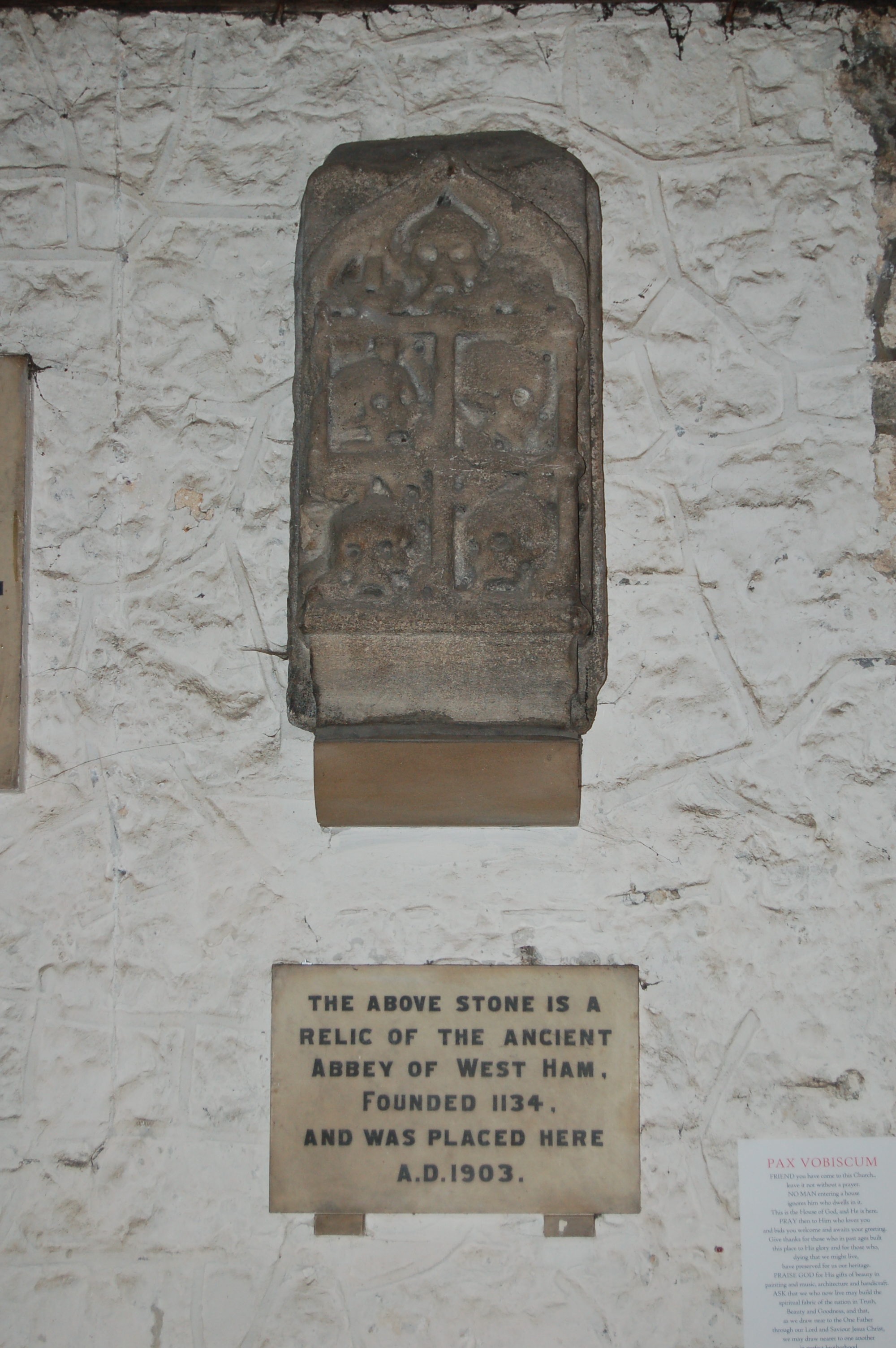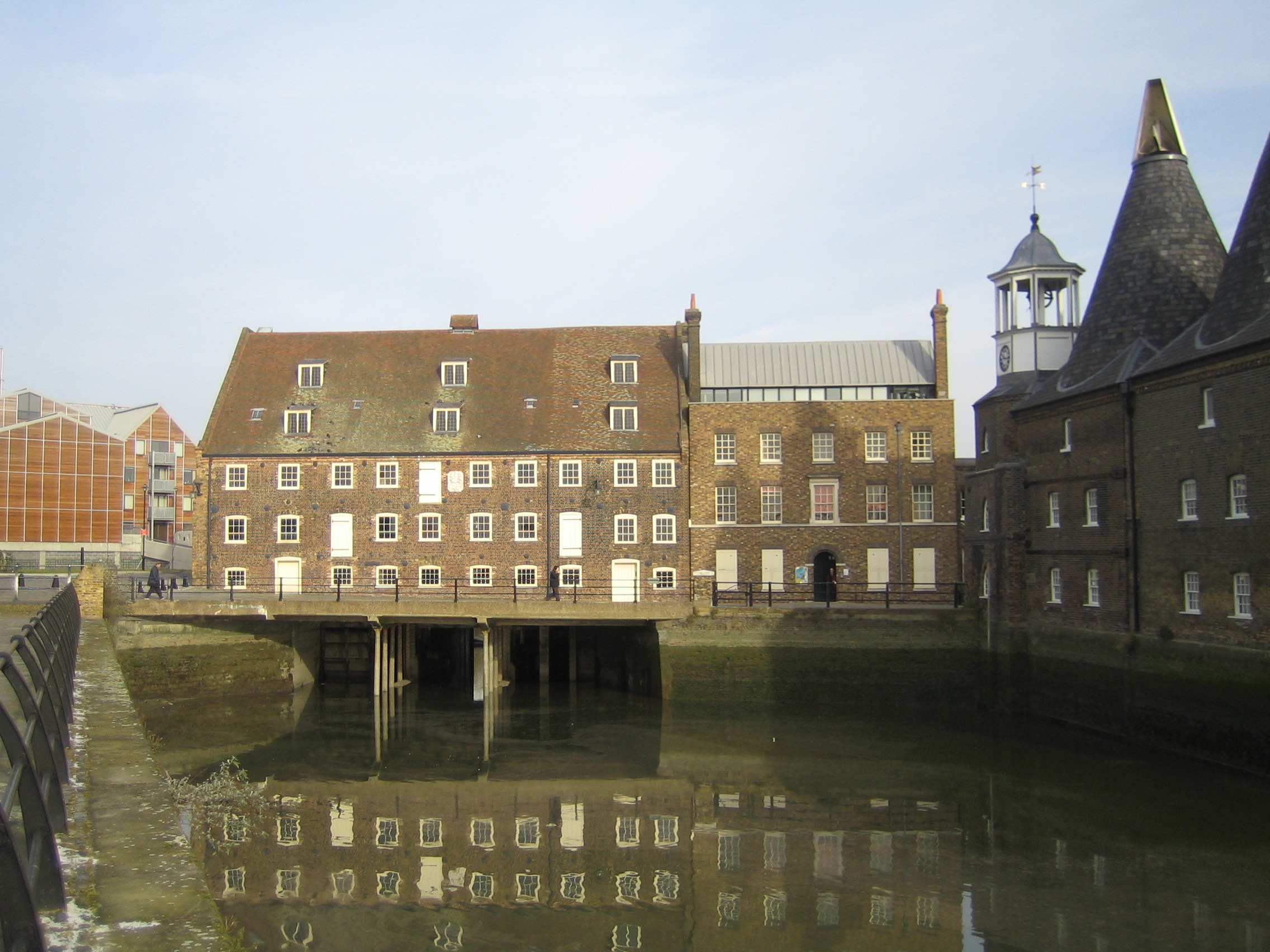|
West Ham
West Ham is an area in East London, located east of Charing Cross in the west of the modern London Borough of Newham. The area, which lies immediately to the north of the River Thames and east of the River Lea, was originally an ancient parish formed to serve parts of the older Manor of Ham, and it later became a County Borough. The district, part of the historic county of Essex, was an administrative unit, with largely consistent boundaries, from the 12th century to 1965, when it merged with neighbouring areas to become the western part of the new London Borough of Newham. The area of the parish and borough included not just central West Ham area, just south of Stratford; but also the sub-districts of Stratford, Canning Town, Plaistow, Custom House, Silvertown, Forest Gate and the western parts of Upton Park, which is shared with East Ham. The district was historically dependent on its docks and other maritime trades, while the inland industrial concentrations ... [...More Info...] [...Related Items...] OR: [Wikipedia] [Google] [Baidu] |
West Ham (UK Parliament Constituency)
West Ham is a constituency created in 1997 and represented in the House of Commons of the UK Parliament since 2005 by Lyn Brown, a member of the Labour Party. Boundaries 1997–2010: The London Borough of Newham wards of Bemersyde, Forest Gate, Hudsons, New Town, Park, Plaistow, Plashet, Stratford, Upton, and West Ham. 2010–present: The London Borough of Newham wards of Canning Town North, Canning Town South, Custom House, Forest Gate North, Forest Gate South, Green Street West, Plaistow North, Plaistow South, Stratford and New Town, and West Ham. The constituency covers the western half of Newham stretching from the Thames just east of Canary Wharf to Stratford. The boundary changes that took effect for the 2010 general election expanded the constituency by adding Canning Town from the abolished Poplar and Canning Town constituency, whilst losing Silvertown to the redrawn East Ham. The boundary with the East Ham constituency was modified to align with local governmen ... [...More Info...] [...Related Items...] OR: [Wikipedia] [Google] [Baidu] |
Upton Park, London
Upton Park is an area of the East London borough of Newham, centred on Green Street which is the boundary between West Ham and East Ham. West Ham United Football Club formerly played at the Boleyn Ground, commonly known as Upton Park. The term 'Upton Park' first applied to a housing estate developed to the east of West Ham Park in the 1880s. The estate took its name from the adjacent village of Upton with the suffix 'Park' added for marketing reasons. The estate's developers paid for a new station to be built which was named after the estate. Consequently, the area surrounding the station became known as Upton Park rather than the term being limited to the original housing estate. Originally a part of the hundred of Becontree, and part of the historic county of Essex, since 1965, Upton Park has been part of the London Borough of Newham, a local government district of Greater London. Football The southern end of Green Street runs alongside the western edge of the former Bo ... [...More Info...] [...Related Items...] OR: [Wikipedia] [Google] [Baidu] |
Essex Regiment
The Essex Regiment was a line infantry regiment of the British Army in existence from 1881 to 1958. The regiment served in many conflicts such as the Second Boer War and both World War I and World War II, serving with distinction in all three. It was formed in 1881 under the Childers Reforms by the amalgamation of the 44th (East Essex) Regiment of Foot and the 56th (West Essex) Regiment of Foot. In 1958, the Essex Regiment was amalgamated with the Bedfordshire and Hertfordshire Regiment to form the 3rd East Anglian Regiment (16th/44th Foot). However, the existence was short-lived and, in 1964, was amalgamated again with the 1st East Anglian Regiment (Royal Norfolk and Suffolk), the 2nd East Anglian Regiment (Duchess of Gloucester's Own Royal Lincolnshire and Northamptonshire) and the Royal Leicestershire Regiment to form the Royal Anglian Regiment. The lineage of the Essex Regiment is continued by 'C' Company of the 1st Battalion of the Royal Anglian Regiment. History Orig ... [...More Info...] [...Related Items...] OR: [Wikipedia] [Google] [Baidu] |
Pals Battalions
The Pals battalions of World War I were specially constituted battalions of the British Army comprising men who had enlisted together in local recruiting drives, with the promise that they would be able to serve alongside their friends, neighbours and colleagues, rather than being arbitrarily allocated to battalions. Establishment At the outbreak of World War I in August 1914 Lord Kitchener, the Secretary of State for War, believed that overwhelming manpower was the key to winning the war, and set about looking for ways to encourage men of all classes to join. This concept stood in direct contrast to centuries of British military tradition, in which the British Army had always relied on professional, rather than conscript, soldiers, and had drawn its members from either the gentry (for officers) or the lower classes (for enlisted men). General Sir Henry Rawlinson suggested that men would be more inclined to enlist in the Army if they knew that they were going to serve alongsi ... [...More Info...] [...Related Items...] OR: [Wikipedia] [Google] [Baidu] |
World War I
World War I (28 July 1914 11 November 1918), often abbreviated as WWI, was one of the deadliest global conflicts in history. Belligerents included much of Europe, the Russian Empire, the United States, and the Ottoman Empire, with fighting occurring throughout Europe, the Middle East, Africa, the Pacific, and parts of Asia. An estimated 9 million soldiers were killed in combat, plus another 23 million wounded, while 5 million civilians died as a result of military action, hunger, and disease. Millions more died in genocides within the Ottoman Empire and in the 1918 influenza pandemic, which was exacerbated by the movement of combatants during the war. Prior to 1914, the European great powers were divided between the Triple Entente (comprising France, Russia, and Britain) and the Triple Alliance (containing Germany, Austria-Hungary, and Italy). Tensions in the Balkans came to a head on 28 June 1914, following the assassination of Archduke Franz Ferdin ... [...More Info...] [...Related Items...] OR: [Wikipedia] [Google] [Baidu] |
Royal Docks
Royal Docks is an area and a ward in the London Borough of Newham in the London Docklands in East London, England. The area is named after three docks – the Royal Albert Dock, the Royal Victoria Dock and the King George V Dock. They are more correctly called the Royal Group of Docks to distinguish them from the Royal Dockyards, Royal being due to their naming after members of the royal family rather than Crown ownership. The three docks collectively formed the largest enclosed docks in the world, with a water area of nearly and an overall estate of . This is equivalent to the whole of central London from Hyde Park to Tower Bridge. The area was designated a special enterprise zone in 2012. North Woolwich is part of Royal Docks ward. Royal Docks is also a ward of the London Borough of Newham. At the 2011 Census it had a population of 10,679. History The three docks were completed between 1855 and 1921 on riverside marshes in East Ham and West Ham (now the London Boro ... [...More Info...] [...Related Items...] OR: [Wikipedia] [Google] [Baidu] |
The Times
''The Times'' is a British daily national newspaper based in London. It began in 1785 under the title ''The Daily Universal Register'', adopting its current name on 1 January 1788. ''The Times'' and its sister paper ''The Sunday Times'' (founded in 1821) are published by Times Newspapers, since 1981 a subsidiary of News UK, in turn wholly owned by News Corp. ''The Times'' and ''The Sunday Times'', which do not share editorial staff, were founded independently and have only had common ownership since 1966. In general, the political position of ''The Times'' is considered to be centre-right. ''The Times'' is the first newspaper to have borne that name, lending it to numerous other papers around the world, such as ''The Times of India'', ''The New York Times'', and more recently, digital-first publications such as TheTimesBlog.com (Since 2017). In countries where these other titles are popular, the newspaper is often referred to as , or as , although the newspaper is of nationa ... [...More Info...] [...Related Items...] OR: [Wikipedia] [Google] [Baidu] |
All Saints Church, West Ham
All Saints Church is a parish church in West Ham, an area in east London. It has been a Grade I listed building since 1984. History Medieval and Tudor In the medieval era the church's parish included all of West Ham, with the one exception of the 24 acres within Stratford Langthorne Abbey's precincts, which formed a separate parish of St Mary and All Saints until the abbey was dissolved, that parish's church was destroyed and the parish itself merged into All Saints. There has been a building on the site since at least the late 12th century - the three blocked clerestory windows on either side of the present building's nave date to that time. One of the founding endowments for the Abbey was land that had belonged to "Ranulph the priest", implying the existence of a parish church. The first concrete reference is a charter of 1181-82 by Henry II of England which confirmed the church of West Ham to the abbey. Gilbert Foliot, bishop of London also assigned a vicar to the parish chur ... [...More Info...] [...Related Items...] OR: [Wikipedia] [Google] [Baidu] |
Metropolitan Building Act
The Metropolitan Buildings Office was formed in 1845 to regulate the construction and use of buildings in the metropolitan area of London, England. Surveyors were empowered to enforce building regulations which sought to improve the standard of houses and business premises, and to regulate activities that might threaten public health. In 1855 the assets, powers and responsibilities of the office passed to the Metropolitan Board of Works. Formation The office was established by the Metropolitan Buildings Act 1844 (7 & 8 Vict., c.84 with the following purposes: * Improvement of drainage * Securing sufficient width of streets to ensure adequate ventilation * Regulation of explosive works * Regulation of "deleterious" works * To appoint officers to superintend the Act Places under the Act The limits in which the Act were to operate were defined as: * On the north side of the River Thames the area within the external boundaries of the parishes of Fulham, Hammersmith, Kensington, Paddi ... [...More Info...] [...Related Items...] OR: [Wikipedia] [Google] [Baidu] |
Bow Bridge (London)
Bow Bridge was a stone bridge built over the River Lea, in what is now London, in the twelfth century. It took its name from the distinctively bow-shaped (curved) arches. It linked Bow in Middlesex with Stratford in Essex. The name has also been applied to replacement structures, with the current structure also, and more commonly, known as ''Bow Flyover''. The Roman Road from Aldgate to Essex and East Anglia had previously forded the Lea further north, half a mile upstream, at Old Ford; the new crossing led the highway to take a more southerly route. The road is known by various names throughout its length, for instance ''Bow Road'' (in Bow) and ''High Street'' and ''Romford Road'' in Stratford, while the whole road was long known as the ''Great Essex Road''. Prior to the construction of the first bridge, settlements on both sides of the river were known as ''Stratford''. Afterwards, the western Stratford settlement become suffixed by “-atte-Bow” (at the Bow), eventually ... [...More Info...] [...Related Items...] OR: [Wikipedia] [Google] [Baidu] |
Stratford Langthorne Abbey
Stratford Langthorne Abbey, or the Abbey of St Mary's, Stratford Langthorne was a Cistercian monastery founded in 1135 at Stratford Langthorne — then Essex but now Stratford in the London Borough of Newham. The Abbey, also known as West Ham Abbey as it lay in that parish, was one of the largest Cistercian abbeys in England, possessing of local land, controlling over 20 manors throughout Essex. The Abbey was self-sufficient for its needs and wealthy besides; some of this wealth came from the ecclesiastic mills grinding wheat for local bakers to supply bread to the City of London. This later led to competition with the Guild of Bakers, who sought powers to levy a toll on loaves entering the City at Whitechapel. History Foundation In a charter dated 25 July 1135, William de Montfichet granted the monks all his lordship of (West) Ham, of meadow, two mills by the causeway of Stratford, his wood of Buckhurst and the tithe of his '' pannage''. The abbey was dedicated in hon ... [...More Info...] [...Related Items...] OR: [Wikipedia] [Google] [Baidu] |
North Woolwich
North Woolwich is an area in the London Borough of Newham in East London. It is located on the northern bank of the River Thames, across the river from Woolwich. It is connected to Woolwich by the Woolwich Ferry and Woolwich foot tunnel. Despite lying on the northern, Essex side of the Thames, the area was within the historic county of Kent. It was part of the parish of Woolwich in the Blackheath hundred and since 1965 has been in the London Borough of Newham. Its position within Kent was an arrangement most likely imposed in the aftermath of the Norman Conquest of England from 1066. The placename North Woolwich was probably taken from North Woolwich railway station which opened in 1847 and closed in 2006; before that, the area was referred to by terms such as "Woolwich in Essex",Powell WR ed. (1973) Becontree hundred: East Ham, in ''A History of the County of Essex: Volume 6'', pp. 1–8. London: Victoria County History.Available onlineat British History Online. Retrieve ... [...More Info...] [...Related Items...] OR: [Wikipedia] [Google] [Baidu] |






_p18b_-_Bow_Bridge.jpg)

